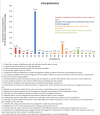Scope and Nature of Pain- and Analgesia-Related Content of the United States Medical Licensing Examination (USMLE)
- PMID: 29365160
- PMCID: PMC6057520
- DOI: 10.1093/pm/pnx336
Scope and Nature of Pain- and Analgesia-Related Content of the United States Medical Licensing Examination (USMLE)
Abstract
Background: "The ongoing opioid crisis lies at the intersection of two substantial public health challenges-reducing the burden of suffering from pain and containing the rising toll of the harms that can result from the use of opioid medications" [1]. Improved pain education for health care providers is an essential component of the multidimensional response to both still-unmet challenges [2,3]. Despite the importance of licensing examinations in assuring competency in health care providers, there has been no prior appraisal of pain and related content within the United States Medical Licensing Examination (USMLE).
Methods: An expert panel developed a novel methodology for characterizing USMLE questions based on pain core competencies and topical and public health relevance.
Results: Under secure conditions, raters used this methodology to score 1,506 questions, with 28.7% (432) identified as including the word "pain." Of these, 232 questions (15.4% of the 1,506 USMLE questions reviewed) were assessed as being fully or partially related to pain, rather than just mentioning pain but not testing knowledge of its mechanisms and their implications for treatment. The large majority of questions related to pain (88%) focused on assessment rather than safe and effective pain management, or the context of pain.
Conclusions: This emphasis on assessment misses other important aspects of safe and effective pain management, including those specific to opioid safety. Our findings inform ways to improve the long-term education of our medical and other graduates, thereby improving the health care of the populations they serve.
Figures





References
Publication types
MeSH terms
Grants and funding
LinkOut - more resources
Full Text Sources
Other Literature Sources
Medical

